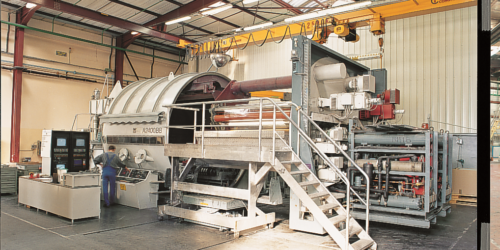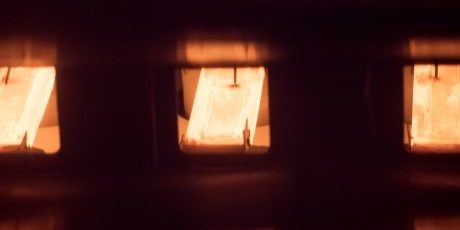Vacuum metallization is a technique that allows to obtain thin layers of metallic deposit on flexible substrates, the most frequently encountered substrates are:
- Polyester type films (PET), polypropylene (BOPP), nylon (BOPA), and polyethylene (PE), polyimides (Kapton)…
- Tissue.
We will rather focus on aluminum deposition because it is widely used for consumer products (food packaging, insulation…):
Used aluminum can have several levels of purity, but generally used of the A5 (purity 99.5%) or even the A9 (purity to 99.9%) in some cases.
Machine to metallize by evaporation under vacuum
The machine to metallize is a vacuum (about 10-4 mbar) equipped with:
- 1 support to metalize unwinding station
- 1 or 2 Bank (s) evaporation (s) consisting of crucibles
- 1 or 2 drum (s) cooling (about – 20 ° C)
- 1 metallic support wrapping station
The principle consists in:
- Place the support you want metallize
- Get the support above the evaporation crucibles (against the cooling drum)
- Wrap the metallic support
The machine is also equipped with a system that continuously measures the amount of aluminum deposited on the substrate. We measure this amount of aluminum either by optical density (OD) or resistivity calculation.

Process description
The crucibles of evaporation (usually in Boron Nitride) are heated at 1500 ° C to allow wire (1.5 mm) aluminium melted in the crucible. There is a passage of aluminum from the solid state to the liquid state (fusion), then a passage of State liquid to gas (evaporation). Aluminum molecules will come to condense on the substrate because it is cooled through the cooling drum to -20°C. (You can make the analogy with steam that condenses on the single-glazed window, when you cook).
The desired amount of aluminum, will be obtained by the adequacy of the “aluminum wire speed” and the “speed of scrolling support”. So when are looking for a low deposit of aluminum, “speed of aluminum wire” will be weak and “support scroll speed” will be high and when looking for a high deposit, the “aluminum wire speed” will be high and the “substrate feed speed” will be low.
Benefits and applications
A machine with 2 banks of evaporation allows a greater range in the amount of aluminum that is filed. Thus one can produce films with low charge (10nm) for applications like one-way mirrors or highly charged films (80nm).
After metallization, the film has the aspect of a mirror, vacuum metallization with aluminum may have several purposes:
- Making barrier films (oxygen, water vapor) for applications in the food industry
- Making low-emission films for insulation
- Embellishing the packaging in the case of luxury or textiles
Michel Malcheaux
Metallization Manager

